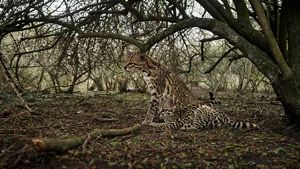Ocelots in Texas
Once found across much of the Lone Star State, today, fewer than 100 ocelots survive in the United States, roaming between South Texas and Mexico.
For ocelots in Texas, conservation means connecting the dots. These “dots” are fragments of habitat—primarily thick, dense thornscrub forest that the ocelot uses to feed, breed and move. These habitats are often disconnected, forcing ocelots to navigate roads and open areas. The Nature Conservancy (TNC) and partners are creating conservation pathways by linking protected lands and working lands to give this species room to roam and recover.
The Elusive Ocelot
Ocelots, similar in size to a bobcat, can grow up to 3.5 feet long and weigh up to 35 pounds. Their distinctive “op-art” pattern features chainlike streaks, spots, blotches and rosettes. Ocelots range from South Texas to northern Argentina, primarily inhabiting dense Tamaulipan thornscrub forest in the Lower Rio Grande Valley, where they prey on small mammals, reptiles and birds. They den in caves, hollow trees and thickets, breeding in late summer and bearing litters of one to three cubs in the fall and winter. However, fewer than 100 ocelots are known to exist in the entire United States.
Historically found across Texas, Louisiana and Arkansas, ocelots' range and population have diminished due to hunting, trapping, poisoning, vehicle strikes, inbreeding and habitat loss. As a result, the subspecies in Texas and northeastern Mexico (Leopardus pardalis albescens) is federally endangered. Today, these cats roam between Texas and Mexico, relying on the few wildlife corridors that remain.


Partners in Protection
Protecting, restoring and reconnecting these corridors is crucial to ocelot recovery. TNC's Lennox Foundation Southmost Preserve serves as a seedling nursery for many of the native plants used to restore ocelot habitat. At the nearby Lower Rio Grande Valley National Wildlife Refuge and the Laguna Atascosa National Wildlife Refuge, the U.S. Fish and Wildlife Service (USFWS) has preserved more than 200,000 acres of land, helping support ocelot populations. The agency and its partners collect data and conduct research about the cats and their habitat at these sites, complementing its extensive habitat restoration program.

Local landowners have always been important partners in safeguarding ocelots. South Texas is home to many heritage farming and ranching operations—and these private landowners are helping fill in missing pieces of the conservation puzzle by preserving existing brush habitat in key places. For example, the Yturria Ranch, a 14,000-acre property in South Texas, serves as a cattle ranch and a wildlife preserve with a breeding population of ocelots. Parts of the ranch with the best native Tamaulipan thornscrub are protected by conservation easements.

A New Approach to Recovery
In 2024, the USFWS approved a Programmatic Safe Harbor Agreement with the East Foundation, a Texas nonprofit and landowner that promotes the advancement of land stewardship through ranching. The agreement ensures that, if private ranchers in certain South Texas counties allow reintroduced ocelots to use their properties as habitat, the USFWS won't require the landowners to alter the management of these ranching operations, as is often the case with endangered species. This will allow working lands to keep working while contributing to ocelot recovery.
Quote: Sonia Nájera
Working with the ranching community is absolutely essential. These private lands offer some of the best intact habitat for ocelots. Allowing these ranches to continue their work is vital for the long-term recovery of ocelots and many other native South Texas species.

A Hopeful Outlook for Ocelots
Partners broke ground on a $20 million ocelot conservation facility in 2024 at the Caesar Kleberg Wildlife Research Center located at Texas A&M University-Kingsville—the first in the nation dedicated to housing ocelots for breeding purposes. It will feature an environment for young ocelots to learn natural behaviors so they can be released onto lands, including those enrolled in the Safe Harbor agreement.
TNC is hopeful that through concerted, innovative efforts like these, ocelots might once again thrive in the native landscape of South Texas.

Quote: Sonia Nájera
The ocelot is an iconic species. While few have probably seen one, I think most people recognize how special it is that we still have places wild enough to support them. They're still out there, sneaking through the thorns. The loss of even one can have a dramatic effect on the species’ future.
We Can’t Save Nature Without You
Sign up to receive monthly conservation news and updates from Texas. Get a preview of Texas' Nature News email.




